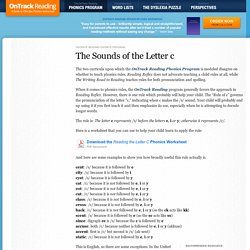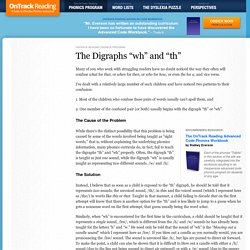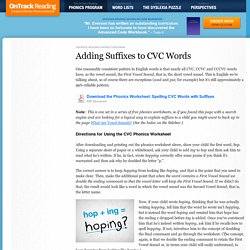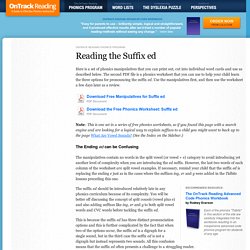

Patrones de escritura en vocales. The Short Vowel Rule. Silent e. Several rules. Sound activities. Phonics glossary. Phonological rule - Wikipedia. A phonological rule is a formal way of expressing a systematic phonological or morphophonological process or diachronic sound change in language.

Phonological rules are commonly used in generative phonology as a notation to capture sound-related operations and computations the human brain performs when producing or comprehending spoken language. They may use phonetic notation or distinctive features or both. Example[edit] Format and notation[edit] The rule given above for intervocalic alveolar flapping describes what sound is changed, what the sound changes to, and where the change happens (in other words, what the environment is that triggers the change).
Taken together and read from left to right, this notation of the rule for intervocalic alveolar flapping states that any alveolar stop consonant (/t/ or /d/) becomes a tap ([ɾ]) in the environment where it is preceded by a stressed vowel and followed by an unstressed one. Characteristics[edit] Types[edit] Notes[edit] References[edit] Vowel length - Wikipedia. Vowel length and related features[edit] Among the languages that have distinctive vowel length, there are some where it may only occur in stressed syllables, e.g. in the Alemannic German dialect and Egyptian Arabic.

In languages such as Czech, Finnish or Classical Latin, vowel length is distinctive in unstressed syllables as well. In some languages, vowel length is sometimes better analyzed as a sequence of two identical vowels. In Finnic languages, such as Finnish, the simplest example follows from consonant gradation: haka → haan. In some cases, it is caused by a following chroneme, which is etymologically a consonant, e.g. jää "ice" ← Proto-Uralic *jäŋe. Rule Revisions. Improved Coding Because the OnTrack Reading Homeschooling Program disregards Ms.

Spalding's five rules for the ending "e" and instead utilizes ending digraphs, Revision #3: Necessary Changes to the Rulesthose particular rules obviously need to be dropped from the presentation. In addition, several other rules can be dropped without harm. They're listed here (from the 5th edition) along with the reason for dropping them. Rules to be Dropped or Modified. Phonics Rules - The Sounds of the Letter g (Free Worksheet) Phonics Rules & Secret Codes! Here is a growing list of phonics rules. There are some exceptions in our English Language when these rules will not work, but in the majority of cases the phonics rules will apply. I have tried where possible to give examples of a word using the phonics rule. Help them to check words to see if the reading rule is correct. It gives the phonics rules a ‘magic’ like quality, like a secret code! Basically always remember to help your child practice applying the new phonics rule to words in print.
Every word must contain a vowel. Phonics rules. Phonics Rules. Phonics Rules The vowels are "a,e,i,o, and u"; also sometimes "y" & "w".

This also includes the diphthongs "oi,oy,ou,ow,au,aw, oo" and many others. The consonants are all the other letters which stop or limit the flow of air from the throat in speech. They are: "b,c,d,f,g,h,j,k,l,m,n,p,qu,r,s,t,v,w,x,y,z,ch,sh,th,ph,wh, ng, and gh". 1. 2. 3. 4. 5. 6. 7. 8. 9. 10. Basic Syllable Rules. Adding Suffixes to Split Vowels (with Free Worksheets) Phonics Rules - The Sounds of the Letter c (Free Worksheet) OnTrack Reading Phonics Program The two curricula upon which the OnTrack Reading Phonics Program is modeled disagree on whether to teach phonics rules.

Reading Reflex does not advocate teaching a child rules at all, while The Writing Road to Reading teaches rules for both pronunciation and spelling. Teaching Decisions: The Digraphs "wh" and “th” OnTrack Reading Phonics Program Many of you who work with struggling readers have no doubt noticed the way they often will confuse what for that, or when for then, or who for how, or even the for a, and vice versa.

I’ve dealt with a relatively large number of such children and have noticed two patterns to their confusion: 1. Most of the children who confuse these pairs of words usually can’t spell them, and 2. Teaching Decisions: The Digraphs “ar” and “or” OnTrack Reading Phonics Program Okay, so this is too long to be called a "tidbit.

" It's actually a rationale for treating the letter combinations "ar" and "or" as digraphs for the sounds /ar/ and /or/ respectively, and is probably only of interest to people involved in the particulars of curriculum design. If that's not you, you're likely to get more out of the next Tidbit, What Are Vowel Sounds?. The Problem Curriculum designers have a choice to make when confronted with the spellings "ar" as in part, and "or" as in cord. The problem arises when you consider both what those two sounds are in each case, and also what they are not. So, the curriculum question becomes “is a child better off identifying two sounds in /ar/ and /or/ or just being trained to identify one sound?” Reading the Digraph “ar” Taking first the case of the digraph "ar" and it’s associated sound /ar/, let’s consider the matter from both the reading and spelling perspectives. 1. 2. 3. 4.
Adding Suffixes to CVC Words (Free Phonics Worksheet) OnTrack Reading Phonics Program One reasonably consistent pattern in English words is that nearly all CVC, CCVC and CCCVC words have, as the vowel sound, the First Vowel Sound, that is, the short vowel sound.

This is English we’re talking about, so of course there are exceptions (wad and put, for example) but it’s still approximately a 99%-reliable pattern. Download the Phonics Worksheet: Spelling CVC Words with Suffixes Note: This is one set in a series of free phonics worksheets, so if you found this page with a search engine and are looking for a logical way to explain suffixes to a child you might want to back up to the page What Are Vowel Sounds? Reading the Suffix ed (with Free Worksheet and Manipulatives) OnTrack Reading Phonics Program Here is a set of phonics manipulatives that you can print out, cut into individual word cards and use as described below.

The second PDF file is a phonics worksheet that you can use to help your child learn the three options for pronouncing the suffix ed. Use the manipulatives first, and then use the worksheet a few days later as a review. Download Free Manipulatives for Suffix ed Download the Free Phonics Worksheet: Suffix ed Note: This is one set in a series of free phonics worksheets, so if you found this page with a search engine and are looking for a logical way to explain suffixes to a child you might want to back up to the page What Are Vowel Sounds? The Ending ed can be Confusing The manipulatives contain no words in the split vowel (or vowel + e) category to avoid introducing yet another level of complexity when you are introducing the ed suffix. The suffix ed should be introduced relatively late in any phonics curriculum because of its complexity.